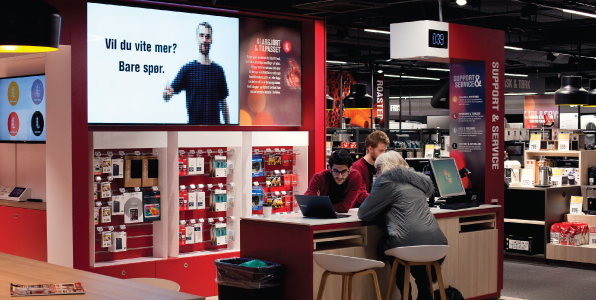When you think of digital signage, you automatically think of retail. They were the early adopters in the 1980 and it has changed drastically over time. The stores are becoming smaller but the product assortment is getting bigger. That is one of the biggest challenges the retail industry is
facing.
Displaying more products in a smaller place is indeed a challenge that many are facing. Some do it well and have increased their sales numbers but others that are still figuring it out and are loosing out to those that do it well. It´s about time for everyone to figure it out.
With the rise of new technology, the digital signage industry is moving into a whole new direction. With more focus on content creation and using software to make content distribution much more effective and relevant to their marketing strategy is key to success when it comes to digital signage.
We at Databeat.Net have generated a list of six things to think of before investing in digital signage.
Publish your content onto to your screens in a matter of seconds.
There are several questions to ask before investing in a digital signage solution. We have gathered a series of questions alongside with answers to help to move forward in the process. So let’s kick off with the first question.
What do you want digital signage to accomplish for your store?
Everything starts with a motive. What are your objectives? Do you want to show advertising in the store? Do you want to use it for informational purposes for your customers? You first must establish the objectives and purpose of using specific technology and software.
Creating a plan and sticking to it is key for the success of the project. Testing out various content and optimizing along the way is also very important before coming to conclusion for what works and what doesn’t. Like all investments, this requires a strategy alongside with a detailed operational plan in order to make it a successful project.
What type of in-store customer experience do you want to create?
One of my favorites quotes when it comes to customer experience is from the late James Cash, founder of JC Penny.
“Courteous treatment will make a customer a walking advertisement.”
Although the quote is from a long time ago it transcends into our time. With the rise of technology, companies have decreased the customer service workforce, simply to save costs and improve the bottom-line.
There are so many missed opportunities because having a great customer experience in the store will, in turn, make your customers a walking advertisement for your company.
Using digital signage to improve the customer experience in the store will benefit the company in many ways. Not using it for only discounts or price information but also showing content that is relevant to your products and company. Showing the benefits of the use of your product and providing information on features or functions.
Tip 1: Map the whole customer experience. Areas where customers stop and ask simple questions, set up screens that provide that simple information and if more specific answers are required have a call to action where an expert can come and talk to them directly.
Tip 2: Show the relevant content to the product category. Having content that is related to that product category, such as how the product is used, is a simple way to increase customer creativity and inspiration. Show short sequence and explanatory videos that the customer can visually see the product in use.
When you start brainstorming, executing and customizing ideas to your store, you will end up adding value to the customer experience.
What type of target audience do you have today and what type of future audiences do you want to attract?
The famous audience question will always be present when it comes to the overall strategy of the company. Mapping out the audience is crucial, and if you have not done it, we strongly recommend doing it. Here is a link on how to do that.
Based on your customer audience, you chose what type of digital signage you will use to further help them in making purchase decisions. You have the basic data that will support you making those decisions. If data shows that your customers often have the need to ask basic questions, adding a series of screens to display most required information about the product and if they are uncertain then they can require more expert help.
What type of new audiences to you want to attract? You have attracted them to the store and now you have to convert them from a potential customer to a paying customer. You have to align the in-store promotion with your current advertising. Showing the same advertising across all platforms displays that the store is up-to-date with the current overall advertising will increase the chances to convert the customer.
Displaying the ads and discounts in areas with the highest foot traffic with high brightness screens will increase the chances for a customer to buy the product which is advertised.
This goes alongside with existing customer audience and the new audience that you want to attract.
How do customers move in the store and which store zones to they spend the most time?
One thing is the customer audience and another is mapping the customer´s movements inside the store. Stores have been good in defining the path that all customers have to follow when they are inside the store. If you haven’t done that, we recommend reading this article in order to get you started.
In order to maximize your stores´ digital signage concept, you have to map out the customer movement inside the store. Defining spaces that customers usually stop and ask for information and zones that customer just passes by. These are the key conversion points.
Most store zones are defined by Entrance area, Point of Sale and Service and info area. These are the zones where customers usually stop and commit to get information. Every zone serves its own purpose and thus must be treated as conversion to action.
When you have defined the area, you set up an ”Inform and Attract” strategy. Zones where customers usually stop or slow their movement, are ideal places that they find the product most interesting and adding value to that with screens that show relevant and dynamic content will increase the chances that the customer will gain more interest and potentially convert into buying.
Informational zones are areas where a customer often stops to get information from the store employees if they don’t find the information that they need by themselves. That is a great chance to show relevant content towards the customer. Adding content to the screens that show premium offers such as ” We will help you with design”, ” We will transport your product for free”. This type of content helps the decision making faster for the customer to chose to buy from your store. This type of content speeds up the decision-making process for your customers.
Why do you want the customers to stop and use more time in certain zones in the store?
As mentioned above in the point 4, retail companies have a well thought out strategy when it comes to defining zones that go alongside with their store. Here is a link that helps figure more about zoning in the store. https://www.shopify.com/retail/the-ultimate-guide-to-retail-store-layouts
The question to ask yourself is why do you want a customer to stop a certain place in the store. What type of value will you provide your customers for stopping at that certain point? Is it show discounts or is to show new exclusive product with new features. You must tailor the content that supports that certain zone. If you have demo zones for your product, what more valuable content can you add to help the customer make the decision into buying the product.
Tip 1: For discounts areas or zones, using bright background colors in your content such as red or yellow, and having short taglines with the price being in focus is a good way to convert customers into purchasing the product.
Tip 2: For new product lines or categories. Displaying information about the new product and showing videos on how the product is being used or how it is installed. Displaying information on what are the benefits or the new features of this new product line with dynamic content and adding a call to action such as ”talk to an expert” if they would require more information about the product.
Tip 3: For demo zones, showing content that helps to get started with the product or displaying information the features of the product. Short video or graphic that displays the needed information is the way to go. Use colors that attract attention, such as red, light blue or yellow. Avoid awkward and small fonts.
How to measure the success of digital signage?
Many have asked that specific question, ” How do I measure the ROI for digital signage? ” We have recently written a blog article on how to do that. You can read it here.
First and foremost you have to set certain objectives for our digital signage investments. What do you want to achieve by using a digital signage solution?
Here some digital signage objectives that are used by many of our customers.
- Instructions to your viewers or customers.
- To inspire
- To simplify in-store processes.
- Generate more sales.
- To inform.
- Turn waiting-lines into value time.
- Help make purchase decisions.
- Attract customers to the store.
- Strengthening the brand.
- Create a great customer experience.
- Give a more modern approach and positive experience.
Depending on your objectives, you have to chose the right screens and software that fits towards your objectives. The feedback you get from your customers is data, and that is gold when it comes to measuring the success of your digital signage solution.
You can get feedback from your customers by conducting 1-2 question survey while they are in the store or when they have committed a transaction. Conducting a daily or weekly survey for your employees with also guide you to see what works and what doesn’t.
When you have chosen your objectives then you can set the goals for measuring ROI the digital signage investment.







.png)